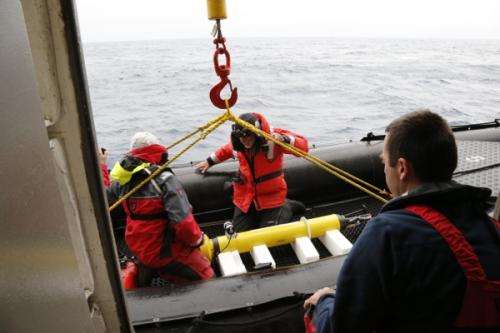Keeping a float: Researchers gather data from high-tech float launched near Antarctica

(Phys.org)—Off the coast of Antarctica, a 4-foot-long, bright yellow tube is drifting through the Southern Ocean and collecting scientific data on the frigid surrounding water.
The recently launched device, called a float, will provide researchers at the University of Delaware—and around the world—with valuable information on ocean conditions in this little-monitored region.
"It's hard to get down there," explained Matthew Oliver, assistant professor of oceanography in the College of Earth, Ocean, and Environment (CEOE). "It's remote, and ice can be a problem."
CEOE supporter and marine science enthusiast Charles W. Robertson Jr. released the autonomous profiling explorer (APEX) float during a cruise last month, dropping it about halfway between Antarctica and the tip of South America in the middle of the Drake Passage. Robertson has given generously to the college in the past, and on this occasion, gave his time as well.
The equipment is one of more than 3,600 similar floats bobbing along underwater in oceans worldwide as part of the international Argo program, a data collection and sharing network formed in 1999 to document climate variability and trends. There are relatively few floats in the Southern Ocean, however, and UD's is one of only two there that takes additional measurements beyond the standard salinity, temperature and pressure.
"The Southern Ocean right now is very under-sampled," Robertson said in a video he made about the launch. "We'd like to at least improve the sampling, and hopefully we can."
The float is specially equipped with an optical instrument that detects chlorophyll and indicates the amount of tiny plants, called phytoplankton, present in the water. Phytoplankton are an important food source for marine life, and they play a role in the exchange of oxygen and carbon dioxide between the ocean and the atmosphere.
Researchers will use the new data to examine which conditions tend to foster phytoplankton growth. By looking at the density of seawater at different depths, they can determine how stable a body of water is and whether that stability has a bearing on how much phytoplankton is growing there.
"The basic question is understanding the relationship between the physics and the chlorophyll distributions in the Southern Ocean," Oliver said, adding that the project builds off of work funded through his research under the New Investigator Program at NASA.
Fabrice Veron, associate professor of physical ocean science and engineering, will assist on the physics side of the research. He will use the water density and temperature information to assess how much mixing there is at the ocean surface and how deep it occurs. Using dissolved oxygen data from the float, he will also study how much of the gas is transported from the surface to deeper waters.
Scientists know that a lot of gas exchange is happening in Southern Ocean based on targeted experiments, Veron said, but they do not have measurements over extended time periods.
"This APEX float is going to provide some long-term time series information about this environment in the Southern Ocean where the waves are big and the wind is blowing quickly, making a lot of gas exchange," Veron said.
Graduate student Alexander Davies will work with both Oliver and Veron to manage the data and analyze the ocean dynamics at play. The free-drifting float is programmed to automatically rise to the surface every week and beam information to a satellite, before descending back underwater.
The battery-powered float will continue this routine for four years, unless ice above blocks it from moving upward. In that situation, an ice-avoidance feature based on temperature would kick in until the barrier moves.
The first surfacing was on Dec. 28, and the device has been operating as planned.
"It's been successful so far," Davies said.
Provided by University of Delaware



















